
Climate threats from global warming are changing in frequency, intensity, area and duration, according to a recent Intergovernmental Panel on Climate Change (IPCC) report.
They also overlap with non-climate risks, the IPCC said, resulting in complex risks that pose various dangers to ecosystems and human societies.
Therefore, climate-resilient infrastructure that can withstand extreme events need to be developed. According to the United Nations Development Programme (UNDP), there is global agreement that national and regional development strategies must incorporate climate adaptation, or risk management.
What is climate-resilient infrastructure (CRI)? The UNDP explained that CRI is defined by the fact that it is planned, constructed, built and operated in a way that predicts, prepares for and adapts to changing climate conditions. It is also capable of withstanding, responding to and recovering quickly from disruptions induced by these climate conditions. Ensured climate resilience is a continuous process throughout the asset's life. Climate resilience measures can mutually reinforce efforts to build resistance to natural hazards.
In May 2023, the World Resources Institute's latest policy brief, "Capacity, Resources, Regulation: Overcoming the Obstacles to Climate-Resilient Sub-National Infrastructure in G20 Countries," was selected as a T20 Policy Recommendation for this year's G20 summit in India.
Think 20 (T20) is an official G20 engagement group. It acts as an "idea bank" for the G20 by bringing together think tanks and high-level specialists to address G20 policy concerns.
According to this policy brief, authors point out that G20 countries are facing massive challenges in implementing CRI, including a lack of capacity and resources, limited financing, and legal, policy and regulatory risks.

The authors put forward the following policy recommendations for the G20 to promote local CRI practices.
First, utilize the capabilities of the G20 and other multilateral development organizations to direct the investment boom into climate-resilient infrastructure. Second, share information and enable local climate-resilient infrastructure practices, and encourage sub-national stakeholders to join in the G20 global infrastructure knowledge and partnership platforms.
According to the 2030 Adaptation Action Agenda, the framework lays forth an ambitious vision for 2030, aiming to increase resilience to both immediate and long-term effects of climate change.
In recent years, nature-based solutions have been practiced in many cities.
An example is Denmark's urban storm water management program. Roads and pipes are laid in built-up areas of Copenhagen's city center to transport water to lakes and harbors. Converting open areas or parks into retention areas that can store large volumes of water, which may turn into lakes in the event of a flood.
The main climate change challenges facing Barcelona include rising temperatures, decreasing rainfall and an increase in extreme events such as droughts and heat waves. Over the years, the city has made efforts to build and maintain urban forests, which effectively lower surface temperatures and reduce the intensity of urban surface runoff and flooding in times of heavy rainfall.

Technological innovations provide solutions for adaptation to climate impacts.
Large-scale rainwater catchment systems used in Denmark, for example, efficiently collect rainwater and discharge it into an artificial lake, where it undergoes a water treatment system to meet standards, and then enters the homes through a separate plumbing system for use in washing machines and toilets.
Underground bioretention and water storage in the Netherlands, placed near the roots of trees, support tree growth through absorption, evapotranspiration, interception and filtration, while enabling rainwater management. Underground structures avoid taking up extra space in crowded cities.
Another example is the Water Retention Landscape in Tamera, Portugal. It includes a system of lakes and other retention systems, as well as other structures like terraces, swales and rotational grazing ponds, to combat such trends as growing erosion and desertification. This method of water management has established a regenerative foundation for independent water supply, the renewal of topsoil, forest, pasture and food production, as well as increased species variety in the wild.
Climate change is already happening, and even an immediate halt to all greenhouse gas emissions will not stop the climate impacts that are already occurring. According to the World Bank, adaptation is not a failure, but a defense against events and risks that have already occurred.
(If you have specific expertise and want to contribute, or if you have a topic of interest that you'd like to share with us, please email us at nature@cgtn.com.)